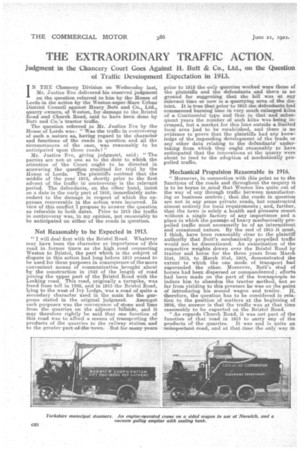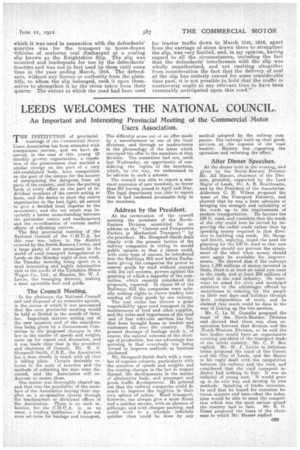THE EXTRAORDINARY TRAFFIC ACTION.
Page 26

Page 27

If you've noticed an error in this article please click here to report it so we can fix it.
Judgment in the Chancery Court Goes Against H. Butt & Co., Ltd., on the Question of Traffic Development Expectation in 1913.
IN THE Chancery Division on Wednesday last, Mr„ Justice Eve delivered his zeserved judgment on the question referred to him by the HOWE of Lords in the action Iby the Westim-super-Mare Urban District Council against Henry .Butt and Co., Ltd., quarry -owners, of 'Weston, for ..damage to the Bristol Road and Church Road, said to have been done by Butt and -Co.'s tractor traffic.
The question referred to Mr. Justice Eve by the House of Lords was: "Was the traffic in controversy of such a nature as, haying regard to the character and functions of the roads in question and all the eircumsta-nces of the ease, was reasonably to be anticipated upon those roads'? "
Mr. Justice Eve, giving judgment, said : "The parties are not at one as to the .date to which the attention of the Court ought to be directed in. answering the question remitted for trial by the House of Lords. , The plaintiffs contend that the middle of the year 1913, shortly prior to the first advent of the traffic in' controversy is the 'relevant period. The defendants, on the other hand, insist on a date in the early part of 1916, immediately antepedent to the damage in respect of which the expenses recoverable in the action were incurred. In view of this conflict I propose to answer the question as referable to both dates. Prior to 1913 the traffic in controversy was, in my opinion, not reasonably to be anticipated on either of the roads in question.
Not Reasonably to be Expected in 1913.
" I will deal first with the Bristol Road. Whatever may have been the character or importance of this road in . former times as the high road connecting Weston to Bristol, the part which is the subject of dispute in this action had long before 1913 ceased to be used for these purposes in consequence of the more convenient means of communication brought about by the construction in 1842 of the length of road joining the upper part of the Bristol Road with the Locking road. This road, originally a turnpike, was freed from toil in 1882, and in 1913 the Bristol Road, lying to the west of Ivy Lodge, was a road of quite a, secondary character used in the main for the pnrposes stated in the original judgment. Amongst such purposes was the conveyance of stone and lime from the quarries on be adjacent hillside, and it may therefore rightly be said that one function of this road was to afford a means of transporting the products of the quarries to the railway .station and to the greater.part7ot,the-tOwn.; But for Many years prior to 1913 the only quarries worked were those of the plaintiffs and the defendants and there is no ground for suggesting that the hill was at any relevant time or now Is a quarrying area of the district: It is,true that :prior to 1913 the defendants had commenced burning lime in very much enlarged kilns of a Continental type and that in that and subsequent years the number of such kilns was being increased, but a market for this lime outside a limited local area liad to be established, and there is no evidence to prove that the plaintiffs had any know: ledge of the impending development of the trade or any other data relating to the defendants' undertaking from which they ought reasonably to have anticipated that the innovations at the quarry wereabout to lead to the adoption of mechanically propelled traffic.
Mechanical Propulsion Reasonable in 1916.
"Moreover, in connection with this point as to the functions of the roads and throughout the enquiry it is to be borne in mind that Weston lies quite out of the way of any through traffic between manufacturing or business centres; that the roads in question are not in any sense private roads, but constructed almost entirely for local requirements; and, farther, that the town is solely a health and pleasure resort without a single factory of any importance and a place in which the passage of heavy mechanically propelled traffic must necessarily be of an intermittent and occasional nature. By the end of 191.5 it must, I think, have been reasonably clear to the plaintiff authority that Butt's mechanically propelled traffic would not be discontinued. An examination of the respective weights drawn over the Bristol Road by tractor and horse for the three years from March 31st, 1913, to March 31st, 1916, demonstrated the extent to which the one mode of transport had superseded the other. Moreover, Butt's stud of horses had been dispersed or commandeered ; efforts had been made on the part of the townspeople to induce him to abandon the tractor method, but so far from yielding to this pressure he was on the -point of introducing his second wagon and trailer If, therefore, the question has to be considered in relation to the position of matters at the beginning of 191n, the answer is that the traffic 'was at that time reasbnably to be eNpeeted on the Bristol Road.
" As regards Church Road, it was not part of the function of that road in 1.913 to carry any of the products of the quarries. It was and is quite an nnimpartant road, and at that time the only .way
which it was used in connection with the defendants' quarries was for the transport in horse-drawn vehicles of seaborne coal discharged at a coaling slip known as the Knightshire Slip. The slip was unsuited and inadequate for use by the defendants' tractors and was not in fact used by them until some time in the year ending March, 1916. The defendants, without any licence or authority from the plaintiffs, to whom the slip belonged, took it upon themselves to strengthen it by the stone taken from their quarry. The extent to which the road had been used for tractor traffic down to March 31st, 1916, apart from the carriage of stone drawn there to strengthen the slip, was very limited, and, in my opinion, having regard to all the circumstances, including the fact that the defendants' interference with the slip was wholly unauthorized, and not omitting altogether from consideration the fact that the delivery of coal at the slip has entirely ceased for some considerable time past, it is not possible to hold that the traffic in controversy ought at any relevant time to have been reasonably anticipated upon this road,"






































